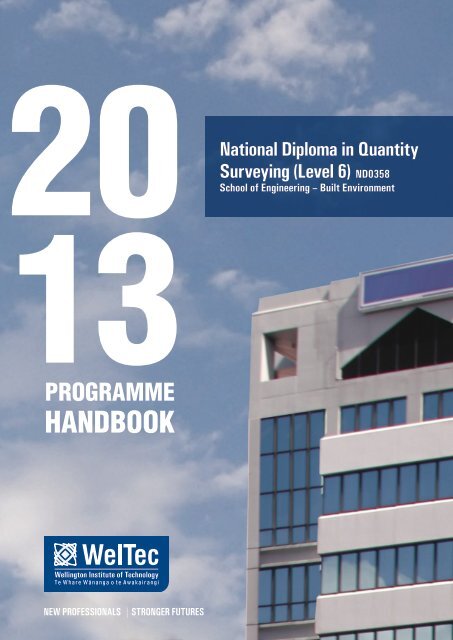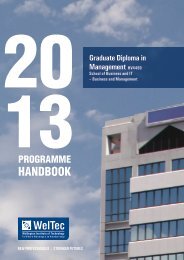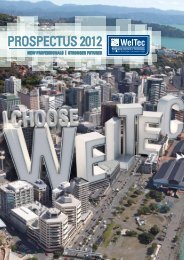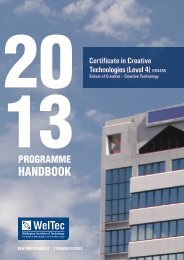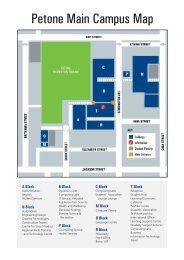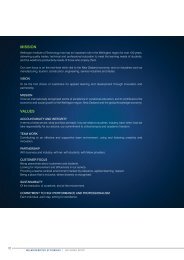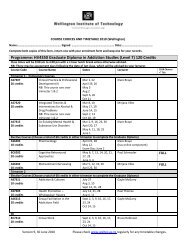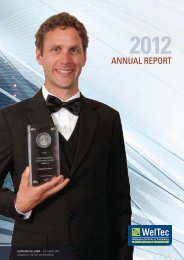HANDBOOK - Wellington Institute of Technology
HANDBOOK - Wellington Institute of Technology
HANDBOOK - Wellington Institute of Technology
You also want an ePaper? Increase the reach of your titles
YUMPU automatically turns print PDFs into web optimized ePapers that Google loves.
PROGRAMME<br />
<strong>HANDBOOK</strong><br />
National Diploma in Quantity<br />
Surveying (Level 6) ND0358<br />
School <strong>of</strong> Engineering – Built Environment
Disclaimer<br />
The information contained in this Programme Handbook is correct at the time <strong>of</strong> publication. However, programmes and courses<br />
are subject to change and WelTec reserves the right to change the content, location or method <strong>of</strong> presentation <strong>of</strong> any<br />
programme or course, and update this Programme Handbook accordingly at any time. The online edition <strong>of</strong> the Programme<br />
Handbook is the <strong>of</strong>ficial Programme Handbook.<br />
Copyright © 2013<br />
<strong>Wellington</strong> <strong>Institute</strong> <strong>of</strong> <strong>Technology</strong> owns copyright in this programme handbook. No part may be reproduced, stored in a retrieval<br />
system or <strong>of</strong>fered for resale without WelTec’s written permission.<br />
<strong>Wellington</strong> <strong>Institute</strong> <strong>of</strong> <strong>Technology</strong> - 2013 Programme Handbook February 2013<br />
ND0358 National Diploma in Quantity Surveying (Level 6)
School <strong>of</strong> Engineering<br />
PROGRAMME <strong>HANDBOOK</strong> 2013<br />
ND0358<br />
National Diploma in Quantity Surveying<br />
(Level 6)<br />
<strong>Wellington</strong> <strong>Institute</strong> <strong>of</strong> <strong>Technology</strong> - 2013 Programme Handbook<br />
ND0358 National Diploma in Quantity Surveying (Level 6)<br />
Publication Date: 26 February 2013
HAERE MAI<br />
Whai korōria ki te atua i runga rawa<br />
Maunga rongo ki te whenua<br />
Whakaaro pai ki ngā Tangata Katoa.<br />
Tena Koutou Katoa,<br />
Tēnei te mihi atu ki a koutou ngā Tauira o<br />
Te Whare Wananga o Te Awakairangi.<br />
Nau mai haere mai ki tēnei Wananga o tātou.<br />
Kia kaha koutou ki te whai mātauranga i tēnei tau, ki te whakarongo<br />
hoki ki ō koutou kaiako.<br />
“Whāia te kotahitanga o te wairua.<br />
Mā te rangimārie me te aroha e paihere”<br />
(pursue unity <strong>of</strong> spirit, which is bound together by peace and aroha)<br />
He mihi nui tēnei kia koutou ngā Tauira o<br />
Te Whare Wananga o Te Awakairangi.<br />
Nau mai haere mai ki tēnei Whare Wananga o tātou.<br />
<strong>Wellington</strong> <strong>Institute</strong> <strong>of</strong> <strong>Technology</strong> - 2013 ND0358 Programme Handbook February 2013<br />
Overview and Programme Specific Information Page 4
CONTENTS<br />
HAERE MAI............................................................................................................................................. 4<br />
CHIEF EXECUTIVE’S WELCOME ......................................................................................................... 6<br />
EXECUTIVE DEAN’S WELCOME .......................................................................................................... 7<br />
INTRODUCTION ..................................................................................................................................... 7<br />
ACADEMIC CALENDAR - 2013 ............................................................................................................. 8<br />
STAFF ................................................................................................................................................... 10<br />
AIMS ...................................................................................................................................................... 10<br />
GRADUATE PROFILE .......................................................................................................................... 10<br />
CAREERS ............................................................................................................................................. 11<br />
STAIRCASING ...................................................................................................................................... 11<br />
PROGRESS THROUGH THE PROGRAMME ..................................................................................... 11<br />
GRADUATION CRITERIA .................................................................................................................... 11<br />
LEARNING AND TEACHING................................................................................................................ 12<br />
ASSESSMENT PROCEDURES ........................................................................................................... 13<br />
Assessment Rationale ................................................................................................................ 13<br />
Assessment Schedule ................................................................................................................ 14<br />
Format Of Assessments ............................................................................................................. 14<br />
Assessment Cover Sheets ......................................................................................................... 14<br />
Submitting Assessment And Assignment Work ......................................................................... 14<br />
Arranging for Late Submission Of Assessments ........................................................................ 15<br />
Applying For An Extension Beyond The Course End Date ........................................................ 15<br />
Penalty for Unarranged Late Submission ................................................................................... 15<br />
Reassessment Of Assessments ................................................................................................. 15<br />
Assessment Results Notification ................................................................................................ 15<br />
Challenging Assessment Decisions ............................................................................................ 16<br />
RISK MANAGEMENT, SAFETY AND HEALTH ................................................................................... 16<br />
ATTENDANCE MATTERS .................................................................................................................... 16<br />
REQUIRED TEXTS ............................................................................................................................... 16<br />
STATIONERY REQUIREMENTS ......................................................................................................... 17<br />
OFF-SITE PRACTICAL AND WORKPLACE COMPONENTS ............................................................. 17<br />
PROGRAMME EVALUATION .............................................................................................................. 17<br />
COURSE DESCRIPTORS .................................................................................................................... 18<br />
<strong>Wellington</strong> <strong>Institute</strong> <strong>of</strong> <strong>Technology</strong> - 2013 ND0358 Programme Handbook February 2013<br />
Overview and Programme Specific Information Page 5
WELCOME TO WELTEC<br />
CHIEF EXECUTIVE’S WELCOME<br />
Greetings, Kia Ora, Tal<strong>of</strong>a Lava, Kia Orana, ni sa Bula Vinaka<br />
Kaise Hai, Sat sri akal, Malo e Lelei, Halo Olgeta, Taloha ni<br />
Marhaba, Bozu, Fakal<strong>of</strong>a Lahi Atu, Annyong haseyo, Ni hao, Namaste<br />
Welcome to <strong>Wellington</strong> <strong>Institute</strong> <strong>of</strong> <strong>Technology</strong><br />
Te Whare Wananga o te Awakairangi<br />
In selecting to learn at <strong>Wellington</strong> <strong>Institute</strong> <strong>of</strong> <strong>Technology</strong> (WelTec), you have chosen a place <strong>of</strong><br />
learning that aims to give you not only the working lifestyle you want, but also, a friendly and<br />
comfortable environment where you can feel at home.<br />
By enrolling at WelTec, you are setting out on a learning journey. What you learn and for what<br />
purpose, are your decisions to make. We want to walk beside you as your coach, partner and<br />
mentor; <strong>of</strong>fering support, facilities, opportunities, tools and information to help you reach your<br />
goals.<br />
When you enrol, you will find that the majority, or maybe all, <strong>of</strong> your courses take place on one<br />
campus. Whether your classes are held at our <strong>Wellington</strong> sites, in Auckland, Christchurch, any <strong>of</strong> our<br />
Petone or other sites, all are your campuses.<br />
With your Student ID card, all services and facilities are there for you to use.<br />
Please let us know if you have any queries or needs we haven’t yet met. Best wishes for a happy and<br />
successful year.<br />
Linda Sissons (Dr)<br />
Chief Executive<br />
<strong>Wellington</strong> <strong>Institute</strong> <strong>of</strong> <strong>Technology</strong> - 2013 ND0358 Programme Handbook February 2013<br />
Overview and Programme Specific Information Page 6
EXECUTIVE DEAN’S WELCOME<br />
Welcome to WelTec – your place for learning. As an institute <strong>of</strong> learning you, as a student, are our<br />
key priority.<br />
All staff at WelTec have one primary focus and that is to help facilitate your learning. As you<br />
progress through your studies please take the opportunity to access the facilities and staff support<br />
available.<br />
Your success is our success.<br />
Julia Hennessy (MEd, MMgt, PGDipHSM, BA, DipN)<br />
Executive Dean<br />
INTRODUCTION<br />
This Programme Handbook is intended to provide information relating to the programme you<br />
are enrolled in with WelTec. There is also an associated WelTec A-Z site that has other<br />
helpful information regarding systems and processes that operate at WelTec.<br />
The most up-to-date version <strong>of</strong> this Programme Handbook and the WelTec A-Z general<br />
information is online at:<br />
http://www.weltec.ac.nz/SH/ND0358.pdf<br />
WelTec’s policies that apply to students and this Programme Handbook are located at:<br />
http://www.weltec.ac.nz/SH/Policy/<br />
<strong>Wellington</strong> <strong>Institute</strong> <strong>of</strong> <strong>Technology</strong> - 2013 ND0358 Programme Handbook February 2013<br />
Overview and Programme Specific Information Page 7
TRIMESTER ONE 2013<br />
TRIMESTER TWO 2013<br />
ACADEMIC CALENDAR - 2013<br />
ND0358 National Diploma in Quantity Surveying<br />
Teaching<br />
Period<br />
Week<br />
No<br />
Monday<br />
date<br />
5 28-Jan<br />
MON TUE WED THU FRI SAT SUN<br />
Auckland<br />
Anniversary<br />
6 4-Feb Waitangi Day<br />
7 11-Feb<br />
8 18-Feb<br />
9 25-Feb<br />
Orientation<br />
Trades<br />
Academy (1)<br />
Mihi<br />
Whakatau;<br />
Orientation<br />
Petone<br />
10 4-Mar Tri 1 Starts<br />
Orientation<br />
Maori<br />
Students<br />
Orientation<br />
Church St,<br />
Cuba St<br />
<strong>Wellington</strong><br />
Orientations:<br />
Auckland;<br />
Trades<br />
Academy (2)<br />
Orientation<br />
Petone<br />
Orientation<br />
Auckland<br />
International<br />
Orientation<br />
Petone<br />
Orientations:<br />
Christchurch;<br />
Youth<br />
Guarantee<br />
11 11-Mar Tri 1 <br />
12 18-Mar<br />
13 25-Mar Tri 1+2 Easter Break<br />
14 1-Apr Easter Break Easter Break <br />
15 8-Apr<br />
Easter<br />
Break<br />
Easter<br />
Break<br />
16 15-Apr<br />
17 22-Apr ANZAC Day<br />
18 29-Apr STUDY TIME (Resits May Be Held During This Time)<br />
19 6-May<br />
20 13-May<br />
21 20-May<br />
22 27-May<br />
23 3-Jun<br />
24 10-Jun<br />
25 17-Jun<br />
Queen’s<br />
Birthday<br />
Tri 1 <br />
26 24-Jun Tri 1 Ends<br />
27 1-Jul<br />
28 8-Jul<br />
29 15-Jul Tri 2 Starts<br />
Tri 1 Results<br />
Completed<br />
30 22-Jul Tri 2 <br />
31 29-Jul Tri 1+2 <br />
32 5-Aug Tri 2+3 <br />
33 12-Aug<br />
34 19-Aug<br />
Graduation<br />
<strong>Wellington</strong><br />
35 26-Aug<br />
36 2-Sep<br />
37 9-Sep<br />
38 16-Sep<br />
39 23-Sep<br />
<strong>Wellington</strong> <strong>Institute</strong> <strong>of</strong> <strong>Technology</strong> - 2013 ND0358 Programme Handbook February 2013<br />
Overview and Programme Specific Information Page 8
TRIMESTER THREE – 2013<br />
Teaching<br />
Period<br />
Week<br />
No<br />
Monday<br />
date<br />
MON TUE WED THU FRI SAT SUN<br />
40 30-Sep YEAR 2 ONLY<br />
41 7-Oct<br />
STUDY TIME (Resits May Be Held During This Time)<br />
42 14-Oct Tri 2 <br />
43 21-Oct<br />
44 28-Oct Labour Day<br />
45 4-Nov Tri 2 Ends<br />
46 11-Nov Tri 3 Starts<br />
47 18-Nov<br />
48 25-Nov<br />
Canterbury<br />
Anniversary<br />
Tri 2<br />
Tri2 Results<br />
Completed<br />
49 2-Dec<br />
50 9-Dec<br />
51 16-Dec<br />
52 23-Dec WelTec closed for Christmas<br />
1<br />
30-Dec-<br />
13<br />
2 6-Jan-14<br />
3 13-Jan<br />
Tri 2+3 <br />
4 20-Jan<br />
5 27-Jan<br />
<strong>Wellington</strong><br />
Anniversary<br />
Auckland<br />
Anniversary<br />
WelTec closed for New Year Holidays<br />
6 3-Feb<br />
Tri 3 Waitangi Day<br />
7 10-Feb<br />
8 17-Feb<br />
9 24-Feb Tri 3 Ends<br />
10 3-Mar Tri 1 Starts<br />
11 10-Mar<br />
Tri 3 Results<br />
Completed<br />
Enr period Last date to change or withdraw in that enrolment period with refund<br />
Enr period<br />
Last date to withdraw (75% <strong>of</strong> course enrolment period)<br />
The up-to-date, day-to-day and week-by-week timetables are located at:<br />
http://timetable.weltec.ac.nz/.<br />
<strong>Wellington</strong> <strong>Institute</strong> <strong>of</strong> <strong>Technology</strong> - 2013 ND0358 Programme Handbook February 2013<br />
Overview and Programme Specific Information Page 9
STAFF<br />
Faculty Executive Dean:<br />
Julia Hennessy<br />
School:<br />
Engineering<br />
Head <strong>of</strong> School:<br />
Graham Carson<br />
Phone/extension 542<br />
E-mail<br />
graham.carson@weltec.ac.nz<br />
Associate Head <strong>of</strong> School: Malcolm Fair<br />
Phone/extension 547<br />
E-mail<br />
malcolm.fair@weltec.ac.nz<br />
School Business Administrator: Ingrid Watts<br />
Phone/extension 533<br />
E-mail<br />
ingrid.watts@weltec.ac.nz<br />
Staff Member Qualifications Position Email Address Cellphone<br />
Petone Campus: 0800 WELTEC (935 832)<br />
Sean Irion BE SASM Sean.irion@weltec.ac.nz 0212816175<br />
Vaughan Maybury BBSc, BArch(Hons),<br />
NCAET, TCCarp<br />
SASM<br />
Vaughan.maybury@weltec.ac.nz<br />
Richard Foreman PGDipAT ASM Richard.Foreman@weltec.ac.nz<br />
Des Hoskins BCons, DipQS ASM Des.Hoskins@weltec.ac.nz<br />
Reo Tanaka MFA ASM Reo.Tanaka@weltec.ac.nz<br />
AIMS<br />
To provide skilled and competent quantity surveying technicians who:<br />
• Apply quantity surveying theory to practice, and competently perform technical operations<br />
to the standards, ethical and pr<strong>of</strong>essional responsibilities required by the quantity surveying<br />
pr<strong>of</strong>ession;<br />
• Have a knowledge sufficient to permit informed, rational decision making in specialist field<br />
<strong>of</strong> quantity surveying and to implement these decisions;<br />
• Will work collaboratively with construction workers, clients, authorities, agencies, industry<br />
and other pr<strong>of</strong>essionals to provide a comprehensive quantity surveying service; and<br />
• Have an understanding <strong>of</strong> all cultures and in particular an awareness and understanding <strong>of</strong><br />
the tangata whenua and the implications <strong>of</strong> the Treaty <strong>of</strong> Waitangi and the Resource<br />
Management Act.<br />
It is expected that graduates will attain the educational underpinnings and work ready<br />
attributes defined in the NZIQS Graduate pr<strong>of</strong>ile for Quantity Surveying Technicians.<br />
GRADUATE PROFILE<br />
On achievement <strong>of</strong> this qualification, graduates should:<br />
• Be competent to apply a technical and conceptual knowledge to practical situations;<br />
<strong>Wellington</strong> <strong>Institute</strong> <strong>of</strong> <strong>Technology</strong> - 2013 ND0358 Programme Handbook February 2013<br />
Overview and Programme Specific Information Page 10
• Be confident, critical thinkers who have the ability to solve problems within a quantity<br />
surveying setting;<br />
• Have developed capabilities as effective communicators, with inquiring, flexible,, creative<br />
and critical attitudes towards contemporary issues and underlying theoretical concepts;<br />
• Have an appreciation <strong>of</strong> management and information technology within the context <strong>of</strong> the<br />
qualification;<br />
• Have an awareness <strong>of</strong> social, ethical and environmental issues;<br />
• Have developed the necessary skills and strategies to work safely and effectively on and<br />
<strong>of</strong>f construction sites and quantity surveying workplaces and with individuals, contractors,<br />
communities, clients and authorities;<br />
• Be self reliant and motivated for continuous learning and pr<strong>of</strong>essional development;<br />
• Function positively in a bi-cultural and multicultural environment such those which existing<br />
New Zealand<br />
• Be work ready and able to be employed in a relevant quantity surveying environment to<br />
work towards and meet the minimum standard <strong>of</strong> competence to practice competently to the<br />
standard expected <strong>of</strong> a reasonable quantity surveyor.<br />
CAREERS<br />
Graduates <strong>of</strong> Quantity Surveying are prepared for entry level work within a Quantity<br />
surveying company. They are also qualified to quantify and tender residential scale projects.<br />
There are many unexplored career options in the area <strong>of</strong> residential construction for a<br />
graduate with this qualification as most Quantity Surveying companies focus on commercial<br />
construction.<br />
STAIRCASING<br />
Bachelor <strong>of</strong> Construction (QS) - Massey University<br />
Bachelor <strong>of</strong> Construction (CE) - UNITEC<br />
The National Diploma forms part <strong>of</strong> the requirements to be a member <strong>of</strong> the <strong>Institute</strong> <strong>of</strong><br />
Quantity Surveyors. Sometimes a summer programme is <strong>of</strong>fered which enables students <strong>of</strong><br />
Quantity Surveying or Construction Management to complete this double major with no<br />
additional year’s study needed.<br />
PROGRESS THROUGH THE PROGRAMME<br />
For full-time students it is a two year programme.<br />
GRADUATION CRITERIA<br />
You must complete the requirements in NC0358 National Diploma in Quantity Surveying as<br />
shown below:<br />
Compulsory<br />
195 credits<br />
The following standards are required:<br />
Construction<br />
9658 Demonstrate knowledge <strong>of</strong> cost estimation processes for a building project<br />
9664 Demonstrate knowledge <strong>of</strong> building law<br />
<strong>Wellington</strong> <strong>Institute</strong> <strong>of</strong> <strong>Technology</strong> - 2013 ND0358 Programme Handbook February 2013<br />
Overview and Programme Specific Information Page 11
9667 Apply principles from published data to the provision <strong>of</strong> services for small<br />
buildings<br />
9668 Apply principles from published data to the provision <strong>of</strong> services for medium and<br />
large buildings<br />
9669 Apply principles from published data to evaluate and select materials and finishes for<br />
buildings<br />
9670 Identify environmental impacts, design, and construction techniques, on and <strong>of</strong> the<br />
built environment<br />
9671 Determine and describe construction methods for small buildings<br />
9672 Determine and describe construction methods for medium and large buildings<br />
Quantity Surveying<br />
10039 Measure schedules <strong>of</strong> quantities for selected trade sections for quantity surveying<br />
10040 Measure schedules <strong>of</strong> quantities for advanced trade sections for quantity surveying<br />
10141 Estimate costs for quantity surveying<br />
10142 Negotiate and apply specified types <strong>of</strong> contracts to tendering situations for quantity<br />
surveying<br />
10143 Complete preliminary estimates and cost plans for a construction project for quantity<br />
surveying<br />
10144 Administer contracts and value building works for quantity surveying<br />
10145 Evaluate and prepare a construction programme for quantity surveying<br />
Elective A<br />
A minimum <strong>of</strong> 20 credits from the specified unit standards<br />
Elective B<br />
A minimum <strong>of</strong> 20 credits, at level 3 or above, is required from the subfield Communication<br />
Skills, <strong>of</strong> which a minimum <strong>of</strong> 10 credits is required from the domain writing<br />
See the National Certificate document for details found at<br />
http://www.nzqa.govt.nz/nqfdocs/quals/doc/0358.doc.<br />
LEARNING AND TEACHING<br />
Lectures<br />
Introduce information and techniques to students that will give them tools by which they can<br />
make informed decisions. Academic staff members will formally present course material to<br />
students and will set the basis for further independent study. Students will be expected to<br />
read ahead and prepare for lecture topics.<br />
Tutorials<br />
Present actual work related cases and highlight areas for special attention that will expose<br />
them to on-site problems. They provide students the opportunity to work with or without<br />
assistance either individually or in groups.<br />
Case Studies<br />
Scenarios are presented and activities are undertaken that they will have to contribute to its<br />
possible resolution.<br />
Student Presentations<br />
Expose students to having to present information to groups as they will be required to<br />
present reports to individuals and groups.<br />
Assignments and Reports<br />
<strong>Wellington</strong> <strong>Institute</strong> <strong>of</strong> <strong>Technology</strong> - 2013 ND0358 Programme Handbook February 2013<br />
Overview and Programme Specific Information Page 12
Students being able to undertake research and present information in a form that is<br />
acceptable to the industry.<br />
Field Visits<br />
Showing theory activities in action in ‘real life’ situations.<br />
Group Activities<br />
Students, as a group, combined together to undertake an activity so they can arrive at a<br />
consensus.<br />
Visiting Speakers<br />
To provide students with the opportunity to hear firsthand about industry practices.<br />
ASSESSMENT PROCEDURES<br />
You need to become familiar with the assessment procedures for your courses and this<br />
Programme. Overall Programme procedures are given below. There may also be course<br />
specific assessment procedures and requirements noted in your Course Outlines.<br />
Please note that all activities that contribute towards your final course grades, and therefore<br />
your qualification completion, are known as assessments (summative assessments to be<br />
precise). There are many different types <strong>of</strong> assessment activities your tutors use in your<br />
courses.<br />
The WelTec Academic Regulations section 7 require that you:<br />
<br />
<br />
make yourself available to undertake all summative assessment items at the time<br />
and place stipulated by the teaching staff responsible for the course<br />
act with integrity (honesty) during assessments. You are expected to:<br />
o Submit material that is your own original work<br />
o Collaborate only as permitted<br />
o Acknowledge contributions from other sources by using APA reference format<br />
(failure to do this correctly may be regarded as plagiarism)<br />
o Keep written and electronic work secure to prevent others from accessing and<br />
copying work<br />
o Understand the definition <strong>of</strong> academic dishonesty and the consequences <strong>of</strong><br />
breaching the regulations (see Academic Regulations S12 Dishonest Practice).<br />
WelTec conducts assessments within rules set out in the following regulations and policies:<br />
The Academic Regulations 2013<br />
o Examination Rules<br />
o Aegrotat regulations<br />
o Grades<br />
o Results<br />
o Challenging Assessment Decisions<br />
o Dishonest Practice in Assessment<br />
o Appeals<br />
Policy 3.05 Assessment Policy<br />
o Definitions<br />
o Guidelines for assessment practice<br />
Policy 3.07 Programme Moderation Policy<br />
o Quality assurance processes before using the assessment activity<br />
o Quality assurance processes after marking to verify marker’s consistency<br />
You may ask your tutors at any time about the quality-assured status <strong>of</strong> the assessment<br />
activities you are asked to complete.<br />
Assessment Rationale<br />
The courses in this programme are assessed using competency-based methods.<br />
<strong>Wellington</strong> <strong>Institute</strong> <strong>of</strong> <strong>Technology</strong> - 2013 ND0358 Programme Handbook February 2013<br />
Overview and Programme Specific Information Page 13
Assessment Schedule<br />
Please refer to your Course Outline for the Assessment Schedule for each <strong>of</strong> your Courses.<br />
The Schedule will detail the assessment type (test, assignment, presentation, etc), the topic<br />
being assessed, due dates, and if appropriate the weighting. Any other conditions will also<br />
be noted as they apply to the assessments for that course.<br />
Format Of Assessments<br />
WRITTEN ASSIGNMENTS/DELIVERABLES<br />
When a Deliverable requires students to produce a report the following rules apply:<br />
1. The report is to be written in Memorandum format<br />
2. The content is to be produced using Micros<strong>of</strong>t Word (Calibri font, font size 12)<br />
3. The report is to have been checked for spelling and grammar.<br />
4. Images inserted into the report (graphics, photographs etc.) are to be appropriately<br />
resolved and scaled.<br />
5. Use APA referencing methods to identify material that is not your original work<br />
6. The report is to be submitted as a single Word file (.docx) on a flash drive (USB memorystick),<br />
with the file name quoting the Deliverable to which it relates (e.g. Deliverable<br />
3.2.docx). There must be only 1 Deliverable per submission. The report must identify the<br />
name(s) and ID number(s) <strong>of</strong> the student(s) making the submission<br />
7. The flash drive used for making the submission must have a physical label securely<br />
attached to it which states the owner student’s name and ID number.<br />
8. Students must retain a safety/back-up copy <strong>of</strong> all submitted work.<br />
Results will be published on aPlus+.<br />
DRAWING ASSIGNMENTS/DELIVERABLES<br />
Refer Richard Foreman’s notes.<br />
Assessment Cover Sheets<br />
A Student Assessment Cover Sheet must be attached to all assessments handed/posted in.<br />
If you’re on campus you can find this form on the Student Intranet:<br />
1. Click on Forms and Documents > Assessment Forms<br />
2. Click on Student Assignment Cover Sheet – ASF007<br />
3. Print <strong>of</strong>f the form.<br />
If you are not on campus you can access them on the WelTec website:<br />
a. Go to the WelTec website: www.weltec.ac.nz.<br />
b. Use the CITRIX link to login to WelTec's intranet (see the A-Z for details)<br />
c. Use instructions 1-3 above to print the cover sheet.<br />
Submitting Assessment And Assignment Work<br />
It is essential that you meet the assessment submission deadlines notified in your Course<br />
Outlines' assessment schedules - unless you have pre-arranged for a late submission with<br />
your tutor. Please refer to your course outlines for any penalties for late submission <strong>of</strong><br />
assessments.<br />
Some assessments may have time-related criteria attached to them. Your course outline will<br />
notify you <strong>of</strong> these particular assessments, and the reasons for the time criteria. Lateness,<br />
absence or early departure from these assessments may carry specific penalties.<br />
<strong>Wellington</strong> <strong>Institute</strong> <strong>of</strong> <strong>Technology</strong> - 2013 ND0358 Programme Handbook February 2013<br />
Overview and Programme Specific Information Page 14
Arranging for Late Submission Of Assessments<br />
It is essential that you meet the assessment submission deadlines notified in your Course<br />
Outlines' assessment schedules - unless you have pre-arranged for a late submission with<br />
your tutor. Please refer to your course outlines for any penalties for late submission <strong>of</strong><br />
assessments.<br />
Some assessments may have time-related criteria attached to them. Your course outline will<br />
notify you <strong>of</strong> these particular assessments, and the reasons for the time criteria. Lateness,<br />
absence or early departure from these assessments may carry specific penalties.<br />
Applying For An Extension Beyond The Course End Date<br />
If you are prevented by illness, injury or exceptional circumstances from completing an<br />
assessment by the course end date, you may apply to the Associate Head <strong>of</strong> School for an<br />
extension to complete the assessment.<br />
The application is to be made in writing as soon as possible and not later than 48 hours<br />
before the assessment due time and date. The application is made on the WelTec Course<br />
Extension Form available from the Student Information Centre and the WelTec website.<br />
Where there are valid reasons, the Associate Head <strong>of</strong> School may grant an extension for a<br />
period <strong>of</strong> no more than three weeks after the course end date. A longer than three weeks’<br />
extension may be recommended by the Associate Head <strong>of</strong> School to the Board <strong>of</strong> Studies'<br />
Achievement Sub-Committee for approval, where there are extenuating circumstances that<br />
justify a longer extension.<br />
Penalty for Unarranged Late Submission<br />
There will be no late submissions without an agreed arrangement.<br />
Reassessment Of Assessments<br />
Students who do not meet the expected level <strong>of</strong> competence at the first assessment will be<br />
<strong>of</strong>fered one reassessment.<br />
However, one further opportunity may be <strong>of</strong>fered at the discretion <strong>of</strong> the tutor in charge <strong>of</strong><br />
the course or assessment. (Note a fee may apply.) The discretionary privilege will be<br />
granted where the student has undertaken remedial work needed to achieve competence<br />
and in the judgement <strong>of</strong> the tutor has a good chance <strong>of</strong> success in that assessment. Any<br />
further requests for reassessment must be submitted in writing to the Associate Head <strong>of</strong><br />
School for approval.<br />
In the event that a reassessment is declined by the tutor in charge <strong>of</strong> the course or<br />
assessment, the student may apply for a review <strong>of</strong> the decision by the Associate Head <strong>of</strong><br />
School.<br />
Assessment Results Notification<br />
Course assessment and final grades are reported using the Grade Key 1 method. Grade<br />
Keys are explained in Appendix 2 <strong>of</strong> the Academic Regulations.<br />
Once your tutor has marked your assessments you will be notified <strong>of</strong> your result.<br />
• If the assessment is in the form <strong>of</strong> a practical in-class demonstration/observation, you are<br />
likely to get your results immediately or shortly after the assessment activity has concluded.<br />
• If the assessment is a supervised test you are able to review your work, but the<br />
assessment is collected and retained by WelTec.<br />
• If you hand in an assignment it is returned to you along with feedback to explain the<br />
reason(s) for the assessment result.<br />
• If you sit a final exam you are able to view your result online at the student results portal:<br />
https://results.weltec.ac.nz within 15 working days.<br />
<strong>Wellington</strong> <strong>Institute</strong> <strong>of</strong> <strong>Technology</strong> - 2013 ND0358 Programme Handbook February 2013<br />
Overview and Programme Specific Information Page 15
Results for each assessment are available within 15 working days on WelTec's Student<br />
Results portal at: https://results.weltec.ac.nz.<br />
Use your normal WelTec login and password to access a number <strong>of</strong> items, such as your<br />
assessment results, current course enrolments, and other details.<br />
Challenging Assessment Decisions<br />
If you have reason to believe that the grade or mark for a particular assessment is incorrect,<br />
you should firstly discuss this with your tutor within five (5) working days <strong>of</strong> the return <strong>of</strong> the<br />
assessment.<br />
Your tutor will provide feedback to clarify why the grade or mark has been awarded and<br />
may, if justified, amend the result.<br />
If you still believe that the mark or grade is incorrect, you should discuss the matter with the<br />
Associate Head <strong>of</strong> School.<br />
For more information on Challenging Assessment Decisions please refer to the WelTec<br />
Academic Regulations 2013 - section 11.<br />
RISK MANAGEMENT, SAFETY AND HEALTH<br />
WelTec students share the responsibility <strong>of</strong> maintaining a safe and healthy working<br />
environment whether on campus or studying <strong>of</strong>f-site (See Student Code <strong>of</strong> Conduct, Section<br />
3.4).<br />
ATTENDANCE MATTERS<br />
An objective <strong>of</strong> study with WelTec is to prepare you for your career in industry. Your attitude,<br />
attendance and behaviour are important. Please give your best effort and ensure your<br />
behaviour and attendance reflect your desire to do well.<br />
You should therefore be present on time, fully equipped and, if applicable, dressed and<br />
groomed appropriately for practical sessions.<br />
You are expected to attend all classes and assessments as timetabled. If you are not able to<br />
attend then you should notify your course tutor.<br />
Note that a student on student allowances/living costs who does not:<br />
• meet prescribed attendance requirements, and/or<br />
• disengages in their learning and assessments, and<br />
• does not respond to contact from the institute,<br />
will be notified to Academic Records and Administration. It is your responsibility to inform<br />
StudyLink if you change your study details.<br />
All daytime classes will have a common start time on the hour and must finish by 50 minutes<br />
past the hour, to allow time for students and staff to arrive at their next class on time.<br />
REQUIRED TEXTS<br />
Your Course Descriptors may identify some text books as required, and/or recommended<br />
textbooks. Please refer to your Course Outlines for the most up-to-date edition information.<br />
Textbooks are available for purchase from vicBooks, <strong>Wellington</strong>, or as specified in the<br />
Course Outlines.<br />
<strong>Wellington</strong> <strong>Institute</strong> <strong>of</strong> <strong>Technology</strong> - 2013 ND0358 Programme Handbook February 2013<br />
Overview and Programme Specific Information Page 16
STATIONERY REQUIREMENTS<br />
You are required to provide items, such as stationery, for your study programme. Tutors will<br />
confirm with you where other equipment and/or materials are required for specific courses or<br />
classes.<br />
OFF-SITE PRACTICAL AND WORKPLACE COMPONENTS<br />
There are no <strong>of</strong>f-site practical/workbased components in the programme.<br />
However you are expected to visit construction sites and document the construction process<br />
photographically for use in reports. It should also be stressed that practical knowledge <strong>of</strong><br />
sites is very valuable and interaction with working sites is encouraged as much as possible.<br />
PROGRAMME EVALUATION<br />
WelTec is interested in the experience students have during their time studying. As well as<br />
informal conversations with students, there are three main surveys available to students to<br />
express their views and rate WelTec services.<br />
As a student new to WelTec:<br />
In the first few weeks you will be invited to participate in the WelTec EV1 - First Impressions<br />
survey (www.surveymonkey.com/s/WelTecEV1). This is open to first-time WelTec students,<br />
and asks for your rating <strong>of</strong> and views about your enrolment experience, the initial in-class<br />
experience, and also your experience <strong>of</strong> our online resource systems, Moodle or LearnZone.<br />
During your course time:<br />
Your course outline may indicate that your course will have an EV4 - Teacher and Course<br />
Evaluation undertaken towards the end. This helps the Programme Team to improve the<br />
teaching, the course, and the value <strong>of</strong> the Programme to students. Note: you will need a<br />
specific 'survey event code' supplied by the survey administrator to use the EV4.<br />
At the end <strong>of</strong> the programme or year:<br />
In the final few weeks <strong>of</strong> the programme, or year, you will be invited to participate in the EV3<br />
- Student Satisfaction Survey (www.surveymonkey.com/s/WelTecEV3). This asks you about<br />
your overall experience <strong>of</strong> WelTec's services, the programme, teaching, skills development,<br />
career enhancement, and overall satisfaction.<br />
All WelTec surveys are anonymous; we do not ask you for identification. We do however ask<br />
for some demographic information (age range, sex, enrolment types, ethnicity, etc.) in order<br />
to make sense <strong>of</strong> trends for particular learner groups.<br />
The outcomes <strong>of</strong> the surveys are reported as aggregated information and tables to the<br />
WelTec Academic Committee. The reports are also made available to students.<br />
<strong>Wellington</strong> <strong>Institute</strong> <strong>of</strong> <strong>Technology</strong> - 2013 ND0358 Programme Handbook February 2013<br />
Overview and Programme Specific Information Page 17
COURSE DESCRIPTORS<br />
Course Descriptors are the formally approved documents that describe:<br />
<br />
<br />
<br />
<br />
<br />
The course title, level, credit value<br />
The aims <strong>of</strong> the course<br />
What you will be learning – the Learning Outcomes that guide the content and<br />
process <strong>of</strong> your learning experiences and activities with your tutor<br />
The assessment activities you need to complete to show how well you have<br />
developed your skills and knowledge against the requirements <strong>of</strong> the Learning<br />
Outcomes<br />
Any external standards that the course is also meeting the requirements <strong>of</strong> (may be<br />
unit standards, pr<strong>of</strong>essional bodies, vendor certifications, etc.)<br />
Course Outlines, which your tutors will provide to you in class, or through LearnZone or<br />
Moodle, contextualise the Descriptors for your particular class for this year. The Outline<br />
should provide you with tutor information, specific course topic schedules, assessment<br />
dates, specific rules and requirements, and other useful information.<br />
The course descriptors for this programme make up the rest <strong>of</strong> this Programme Handbook<br />
on the following pages.<br />
<strong>Wellington</strong> <strong>Institute</strong> <strong>of</strong> <strong>Technology</strong> - 2013 ND0358 Programme Handbook February 2013<br />
Overview and Programme Specific Information Page 18
COURSE TITLE:<br />
Course Number:<br />
Building Science<br />
BD5000<br />
Level: 5<br />
Credits: 15<br />
Pre or Co requisites:<br />
Learning Hours:<br />
Face-to-face tuition 35<br />
Self-directed with tutorial support<br />
available<br />
33<br />
Online 24<br />
Distance (not online)<br />
Resource based learning (not<br />
online)<br />
Workplace learning<br />
Supervised work experience<br />
Self-directed (out <strong>of</strong> class without direct<br />
tutorial support)<br />
Workplace project<br />
Tests and examinations 2<br />
Other<br />
(State)……………………………..<br />
56<br />
Total learning hours 150<br />
Aim(s):<br />
The aim <strong>of</strong> this course is to enable candidates to investigate and understand the<br />
scientific principles that determine the behaviour <strong>of</strong> materials and the relevant<br />
technical and legal processes involved in the design and construction <strong>of</strong> a building<br />
project.<br />
Topic(s) or summary <strong>of</strong> content:<br />
1. Feasibility study<br />
2. Materials <strong>Technology</strong>
Topic 1:<br />
Feasibility study<br />
Learning Outcome(s):<br />
1. Understand the considerations to be made during the design, construction and<br />
costing <strong>of</strong> a building project.<br />
2. Can prepare site visit reports giving details <strong>of</strong> site investigation, archive research<br />
and legal constraints.<br />
3. Evaluate and describe topographical and geotechnical factors.<br />
4. Determine the properties and lifespan <strong>of</strong> a range <strong>of</strong> building materials for a<br />
specific type <strong>of</strong> building<br />
Assessment criteria:<br />
1. Identify the limitations on a site<br />
2. Explain feasibility study in terms <strong>of</strong> legislative requirements<br />
3. Establish the condition <strong>of</strong> a building<br />
Topic 2:<br />
Learning Outcome(s):<br />
Materials <strong>Technology</strong><br />
1. Determine the uses and limitations <strong>of</strong> a range <strong>of</strong> common construction materials.<br />
2. Collect material data from practical work and publications<br />
3. Interpret descriptive data summarised in manufactures tables and diagram’s<br />
4. Understand the properties, structure and performance <strong>of</strong> common building<br />
materials.<br />
5. Understand the compatibility <strong>of</strong> different building materials.<br />
6. Identify the role <strong>of</strong> water in the degradation <strong>of</strong> building materials<br />
Assessment criteria:<br />
1. Explain the characteristics and physical properties <strong>of</strong> materials and finishes used<br />
in buildings<br />
2. Assess performance and compatibility <strong>of</strong> materials and finishes used in buildings<br />
3. Select materials and finishes to be used in buildings.<br />
Student Resources:<br />
Recommended texts as listed in the course handbook.<br />
Assessment:<br />
Assessment is competency based and the following methods which may be used<br />
include:<br />
• Observation <strong>of</strong> practical skill<br />
• Completion <strong>of</strong> practical task<br />
• Written assignment<br />
• Test or examination<br />
• Case Study<br />
• Project Report and/or presentation
Reporting Grades:<br />
Grade Key 1<br />
Successful Completion <strong>of</strong> Course:<br />
Students must achieve all available course credits
COURSE TITLE:<br />
Course Number:<br />
Residential Construction<br />
BD5001<br />
Level: 5<br />
Credits: 15<br />
Pre or Co requisites:<br />
Learning Hours:<br />
Face-to-face tuition 35<br />
Self-directed with tutorial support<br />
available<br />
33<br />
Online 24<br />
Distance (not online)<br />
Resource based learning (not<br />
online)<br />
Workplace learning<br />
Supervised work experience<br />
Self-directed (out <strong>of</strong> class without direct<br />
tutorial support)<br />
Workplace project<br />
Tests and examinations 2<br />
Other<br />
(State)……………………………..<br />
56<br />
Total learning hours 150<br />
Aim(s):<br />
The aim <strong>of</strong> this course is to enable candidates to investigate and understand the<br />
construction technology in relation to buildings <strong>of</strong> a domestic scale not exceeding two<br />
storeys. Identify materials used for the different elements <strong>of</strong> a building project<br />
including components <strong>of</strong> specific design.<br />
Topic(s) or summary <strong>of</strong> content:<br />
1. Domestic Construction
Topic 1:<br />
Learning Outcome(s):<br />
Domestic Construction<br />
1. Describe and detail different types <strong>of</strong> foundations and the conditions in which they<br />
are likely to be used.<br />
2. Describe and detail in-situ concrete and suspended timber framed floors<br />
3. Describe and detail the structural function <strong>of</strong> walls and ro<strong>of</strong>s and identify typical<br />
structural elements<br />
4. Describe and detail external cladding, vapour barrier and insulation<br />
5. Describe methods <strong>of</strong> forming openings installation <strong>of</strong> external joinery and<br />
associated weatherpro<strong>of</strong>ing.<br />
6. Explain the factors influencing the choice <strong>of</strong> ro<strong>of</strong> systems and coverings<br />
7. Describe typical internal finishes and the functions <strong>of</strong> paint<br />
8. Identify and describe the component parts and design <strong>of</strong> stairs<br />
9. Prepare a typical schedule <strong>of</strong> finishes and hardware for a domestic dwelling<br />
Assessment criteria:<br />
1. Describe the site<br />
2. Evaluate and explain the foundations and sub-structure<br />
3. Design and describe the structure <strong>of</strong> a small building <strong>of</strong> non-specific design<br />
4. Evaluate and describe the structure <strong>of</strong> a small building <strong>of</strong> specific design<br />
5. Determine and describe the envelope <strong>of</strong> a small building<br />
6. Determine and describe the methods used to construct the interior <strong>of</strong> a small<br />
building<br />
Student Resources:<br />
Recommended texts as listed in the course handbook<br />
Assessment:<br />
Assessment is competency based and the following methods which may be used<br />
include:<br />
• Observation <strong>of</strong> practical skill<br />
• Completion <strong>of</strong> practical task<br />
• Written assignment<br />
• Test or examination<br />
• Case Study<br />
• Project Report and/or presentation<br />
Reporting Grades:<br />
Grade Key 1<br />
Successful Completion <strong>of</strong> Course:<br />
Students need to demonstrate competence in all assessment criteria.
COURSE TITLE:<br />
Course Number:<br />
Residential Services<br />
BD5002<br />
Level: 5<br />
Credits: 15<br />
Pre or Co requisites:<br />
Learning Hours:<br />
Face-to-face tuition 35<br />
Self-directed with tutorial support<br />
available<br />
33<br />
Online 24<br />
Distance (not online)<br />
Resource based learning (not<br />
online)<br />
Workplace learning<br />
Supervised work experience<br />
Self-directed (out <strong>of</strong> class without direct<br />
tutorial support)<br />
Workplace project<br />
Tests and examinations 2<br />
Other<br />
(State)……………………………..<br />
56<br />
Total learning hours 150<br />
Aim(s):<br />
The aim <strong>of</strong> this course is to enable candidates to understand and report on the<br />
principles and applications <strong>of</strong> building services systems to domestic buildings and the<br />
need to integrate their installation during construction.<br />
Topic(s) or summary <strong>of</strong> content:<br />
1. Domestic Services<br />
2. Write a report
Topic 1:<br />
Domestic Services<br />
Learning Outcome(s):<br />
1. Understand and report on the factors that affect the design <strong>of</strong> service systems<br />
2. Describe control, monitoring and installation <strong>of</strong> system supplying water, electricity<br />
and gas.<br />
3. Describe the features and installation <strong>of</strong> sanitation and drainage systems<br />
4. Describe the features and installation <strong>of</strong> domestic heating systems<br />
5. Describe the features and operation <strong>of</strong> a residential security and fire alarm<br />
system<br />
Assessment criteria:<br />
1. Explain purposes <strong>of</strong> services in small buildings<br />
2. Explain principles <strong>of</strong> operation relevant to services in small buildings<br />
3. Explain principles <strong>of</strong> coordination and placement <strong>of</strong> services in small buildings.<br />
4. Identify legislative requirements relevant to services in small buildings<br />
Topic 2: Write a report<br />
Learning Outcome(s):<br />
1. Write a report<br />
Assessment criteria:<br />
1. Write a report<br />
Student Resources:<br />
Recommended texts as listed in the course handbook.<br />
Assessment:<br />
Assessment is competency based and the following methods which may be used<br />
include:<br />
• Observation <strong>of</strong> practical skill<br />
• Completion <strong>of</strong> practical task<br />
• Written assignment<br />
• Test or examination<br />
• Case Study<br />
• Project Report and/or presentation<br />
Reporting Grades:<br />
Grade Key 1<br />
Successful Completion <strong>of</strong> Course:<br />
Students need to demonstrate competence in all assessment criteria.
COURSE TITLE:<br />
Course Number:<br />
Built Environment<br />
BD5003<br />
Level: 5<br />
Credits: 15<br />
Pre or Co requisites:<br />
Learning Hours:<br />
Face-to-face tuition 35<br />
Self-directed with tutorial support<br />
available<br />
33<br />
Online 24<br />
Distance (not online)<br />
Resource based learning (not<br />
online)<br />
Workplace learning<br />
Supervised work experience<br />
Self-directed (out <strong>of</strong> class without direct<br />
tutorial support)<br />
Workplace project<br />
Tests and examinations 2<br />
Other<br />
(State)……………………………..<br />
56<br />
Total learning hours 150<br />
Aim(s):<br />
The aim <strong>of</strong> this course is to enable candidates to extend their understanding <strong>of</strong><br />
scientific principles and to develop their ability to apply the principles to<br />
environmental factors associated with the built environment.<br />
Topic(s) or summary <strong>of</strong> content:<br />
1. The Built Environment<br />
2. Presentation Skills
Topic 1:<br />
Learning Outcome(s):<br />
The Built Environment<br />
1. Identify daylight factors and calculate daylight factors from simple plans<br />
2. Design artificial lighting requirements for a domestic building<br />
3. Investigate and recommend ways in which sound can be controlled at source, in<br />
transit and at reception.<br />
4. Calculate the flow <strong>of</strong> heat energy through a composite structure and propose<br />
procedures to minimise heat loss/gain<br />
5. Identify risks <strong>of</strong> condensation and the various methods used to minimise these<br />
risks.<br />
6. Evaluate the various types <strong>of</strong> heating systems and list the various implications<br />
when selecting different fuel and energy sources<br />
7. Evaluate the impact <strong>of</strong> local weather conditions on a domestic scaled building<br />
and describe the implications this has in relation to design, cost and buildability.<br />
8. Evaluate and describe the impacts construction has on the natural environment.<br />
Assessment criteria:<br />
1. Identify environmental aspects <strong>of</strong> building construction and services<br />
2. Evaluate design and construction techniques and / or impacts that may apply to<br />
the built environment<br />
Topic 2:<br />
Presentation Skills<br />
Learning Outcome(s):<br />
1. The student will learn to research information and compile their findings into a<br />
structured presentation.<br />
2. The student will be capable <strong>of</strong> presenting their findings orally to a selected<br />
audience.<br />
Assessment criteria:<br />
1. Gather material for an oral presentation<br />
2. Structure and oral presentation to an audience<br />
3. Deliver an oral presentation to an audience<br />
Student Resources:<br />
Recommended texts as listed in the course handbook.<br />
Assessment:<br />
Assessment is competency based and the following methods which may be used<br />
include:<br />
• Observation <strong>of</strong> practical skill<br />
• Completion <strong>of</strong> practical task<br />
• Written assignment<br />
• Test or examination<br />
• Case Study<br />
• Project Report and/or presentation
Reporting Grades:<br />
Grade Key 1<br />
Successful Completion <strong>of</strong> Course:<br />
Students need to demonstrate competence in all assessment criteria.
COURSE TITLE: Measurement 1<br />
Course Number:<br />
BD5004<br />
Level: 5<br />
Credits: 15<br />
Pre or Co requisites:<br />
BD5001 (C)<br />
Learning Hours:<br />
Face-to-face tuition 35<br />
Self-directed with tutorial support<br />
available<br />
33<br />
Online 24<br />
Distance (not online)<br />
Resource based learning (not<br />
online)<br />
Workplace learning<br />
Supervised work experience<br />
Self-directed (out <strong>of</strong> class without direct<br />
tutorial support)<br />
Workplace project<br />
Tests and examinations 2<br />
Other<br />
(State)……………………………..<br />
56<br />
Total learning hours 150<br />
Aim(s):<br />
The aim <strong>of</strong> this course is to provide students with the knowledge to be able to<br />
assemble trade section documentation and measure schedules <strong>of</strong> quantities for a<br />
small domestic scaled building<br />
Topic(s) or summary <strong>of</strong> content:<br />
1. Measurement for domestic scaled buildings
Topic 1:<br />
Learning Outcome(s):<br />
Measurement for domestic scaled buildings<br />
1. Extract dimensions/construction descriptions from drawings and specifications for<br />
a low-rise domestic building.<br />
2. Measure the work for a low rise domestic building using a standard method <strong>of</strong><br />
measurement<br />
3. Prepare selected sections <strong>of</strong> a Bill <strong>of</strong> Quantities<br />
Assessment criteria:<br />
1. Assemble trade section documentation<br />
2. Measure schedules <strong>of</strong> quantities from project information<br />
Student Resources:<br />
Recommended texts as listed in the course handbook.<br />
Assessment:<br />
Assessment is competency based and the following methods which may be used<br />
include:<br />
• Observation <strong>of</strong> practical skill<br />
• Completion <strong>of</strong> practical task<br />
• Written assignment<br />
• Test or examination<br />
• Case Study<br />
• Project Report and/or presentation<br />
Reporting Grades:<br />
Grade Key 1<br />
Successful Completion <strong>of</strong> Course:<br />
Students need to demonstrate competence in all assessment criteria.
COURSE TITLE:<br />
Course Number:<br />
Building Law<br />
BD5005<br />
Level: 5<br />
Credits: 15<br />
Pre or Co requisites:<br />
Learning Hours:<br />
Face-to-face tuition 35<br />
Self-directed with tutorial support<br />
available<br />
33<br />
Online 24<br />
Distance (not online)<br />
Resource based learning (not<br />
online)<br />
Workplace learning<br />
Supervised work experience<br />
Self-directed (out <strong>of</strong> class without direct<br />
tutorial support)<br />
Workplace project<br />
Tests and examinations 2<br />
Other<br />
(State)……………………………..<br />
56<br />
Total learning hours 150<br />
Aim(s):<br />
The aim <strong>of</strong> this course is to provide students with the knowledge to be able to identify<br />
and explain the principles <strong>of</strong> New Zealand law and alternative dispute resolution as<br />
they apply to the construction industry. They will also be able to present a reasoned<br />
argument in a report.<br />
Topic(s) or summary <strong>of</strong> content:<br />
1. Building Law<br />
2. Read texts to research information
Topic 1:<br />
Building Law<br />
Learning Outcome(s):<br />
1. Understand relevant legislation and common law philosophies and<br />
responsibilities within the construction industry role<br />
2. Ensure subordinates are aware <strong>of</strong> their legal duties and responsibilities<br />
3. Communicate effectively in order to avoid a breach <strong>of</strong> legal duties and<br />
responsibilities<br />
4. Extract legal principles that apply to a given scenario/case study and explain the<br />
legal implications.<br />
5. Describe the law <strong>of</strong> tort and in particular negligence and explain the relevance to<br />
the work <strong>of</strong> the construction industry.<br />
6. Define what is meant by a legal contract and the rights and obligations <strong>of</strong> the<br />
various parties to a contract<br />
Assessment criteria:<br />
1. Identify aspects <strong>of</strong> the New Zealand legal structure<br />
2. Describe the principles <strong>of</strong> selected branches <strong>of</strong> New Zealand civil law in terms <strong>of</strong><br />
their relevance to the construction industry.<br />
3. Explain aspects <strong>of</strong> New Zealand law relating to business entities<br />
4. Explain legal fundamentals <strong>of</strong> dispute resolution<br />
Topic 2:<br />
Learning Outcome(s):<br />
Read texts to research information<br />
1. Refer to relevant sources for information and advice on legal issues<br />
2. Carry out research on the legal system as it relates to the construction industry<br />
3. Prepare a list <strong>of</strong> sources <strong>of</strong> information and list the major statutes in regard to the<br />
construction industry<br />
Assessment criteria:<br />
1. Read texts to research information<br />
Student Resources:<br />
Recommended texts as listed in the course handbook.<br />
Assessment:<br />
Assessment is competency based and the following methods which may be used<br />
include:<br />
• Observation <strong>of</strong> practical skill<br />
• Completion <strong>of</strong> practical task<br />
• Written assignment<br />
• Test or examination<br />
• Case Study<br />
• Project Report and/or presentation
Reporting Grades:<br />
Grade Key 1<br />
Successful Completion <strong>of</strong> Course:<br />
Students need to demonstrate competence in all assessment criteria.
COURSE TITLE:<br />
Course Number:<br />
Tendering (A)<br />
BD5108<br />
Level: 5<br />
Credits: 15<br />
Pre or Co requisites:<br />
Learning Hours:<br />
Face-to-face tuition 35<br />
Self-directed with tutorial support<br />
available<br />
33<br />
Online 24<br />
Distance (not online)<br />
Resource based learning (not<br />
online)<br />
Workplace learning<br />
Supervised work experience<br />
Self-directed (out <strong>of</strong> class without direct<br />
tutorial support)<br />
Workplace project<br />
Tests and examinations 2<br />
Other<br />
(State)……………………………..<br />
56<br />
Total learning hours 150<br />
Aim(s):<br />
The aim <strong>of</strong> this course is to provide students with the knowledge to be able to obtain,<br />
analyse and select subcontract quotations and apply specific types <strong>of</strong> construction<br />
contracts to tendering and procurement.<br />
Topic(s) or summary <strong>of</strong> content:<br />
1. Construction Contracts<br />
2. Write in plain English
Topic 1:<br />
Learning Outcome(s):<br />
Construction Contracts<br />
1. Negotiate and apply specified types <strong>of</strong> contracts to tendering situations<br />
2. Identify the job requirements in terms <strong>of</strong> plant, materials, labour, and obtain<br />
competitive supply arrangements.<br />
3. Issue the appropriate sub contract forms for the provision <strong>of</strong> sub contract services<br />
and track distribution on a simple computer spreadsheet.<br />
4. Explain the procedure for selecting suitable sub contract services<br />
5. Produce an ‘Invitation to Tender’ to suppliers and sub contractors<br />
6. Identify the commonly used forms <strong>of</strong> contractual arrangements for tendering<br />
Assessment criteria:<br />
1. Obtain and select subcontract quotations<br />
2. Apply specified types <strong>of</strong> construction contracts to tendering and procurement<br />
situations<br />
Topic 2:<br />
Learning Outcome(s):<br />
Write in Plain English<br />
1. Write documents in plain English<br />
Assessment criteria:<br />
1. Understand plain English<br />
2. Write documents in plain English<br />
Student Resources:<br />
Recommended texts as listed in the course handbook.<br />
Assessment:<br />
Assessment is competency based and the following methods which may be used<br />
include:<br />
• Observation <strong>of</strong> practical skill<br />
• Completion <strong>of</strong> practical task<br />
• Written assignment<br />
• Test or examination<br />
• Case Study<br />
• Project Report and/or presentation<br />
Reporting Grades:<br />
Grade Key 1<br />
Successful Completion <strong>of</strong> Course:<br />
Students need to demonstrate competence in all assessment criteria.
COURSE TITLE:<br />
Course Number:<br />
Contract Administration (A)<br />
BD6208<br />
Level: 6<br />
Credits: 15<br />
Pre or Co requisites:<br />
Learning Hours:<br />
Face-to-face tuition 28<br />
Self-directed with tutorial support<br />
available<br />
26<br />
Online 24<br />
Distance (not online)<br />
Resource based learning (not<br />
online)<br />
Workplace learning<br />
Supervised work experience<br />
Self-directed (out <strong>of</strong> class without direct<br />
tutorial support)<br />
Workplace project<br />
Tests and examinations 2<br />
Other<br />
(State)……………………………..<br />
70<br />
Total learning hours 150<br />
Aim(s):<br />
The aim <strong>of</strong> this course is to provide students with the knowledge to be able to<br />
administer construction contracts and value building works including valuation <strong>of</strong><br />
completed work, variations, fluctuations and time extensions; adjustment <strong>of</strong><br />
nominated sums and preparation <strong>of</strong> final accounts.<br />
Establish communication protocols and participate in formal meetings associated<br />
with construction projects.<br />
Topic(s) or summary <strong>of</strong> content:<br />
1. Contracts and value building works<br />
2. Formal Meeting
Topic 1:<br />
Learning Outcome(s):<br />
Contracts and value building works<br />
1. Administer contracts and value building works for quantity surveying<br />
Assessment criteria:<br />
1. Establish communication protocols<br />
2. Value work executed<br />
3. Evaluate costs <strong>of</strong> variations and fluctuations<br />
4. Evaluate the cost <strong>of</strong> time extensions<br />
5. Adjust nominated sums in accordance with contract requirements<br />
6. Prepare interim and final account statements<br />
Topic 2:<br />
Formal Meeting<br />
Learning Outcome(s):<br />
1. Participate in a formal meeting<br />
Assessment criteria:<br />
1. Demonstrate knowledge <strong>of</strong> formal meetings and their procedures<br />
2. Prepare for a formal meeting<br />
3. Contribute to a formal meeting<br />
Student Resources:<br />
Recommended texts as listed in the course handbook.<br />
Assessment:<br />
Assessment is competency based and the following methods which may be used<br />
include:<br />
• Observation <strong>of</strong> practical skill<br />
• Completion <strong>of</strong> practical task<br />
• Written assignment<br />
• Test or examination<br />
• Case Study<br />
• Project Report and/or presentation<br />
Reporting Grades:<br />
Grade Key 1<br />
Successful Completion <strong>of</strong> Course:<br />
Students need to demonstrate competence in all assessment criteria.
COURSE TITLE: Cost Estimation 1<br />
Course Number:<br />
BD4000<br />
Level: 4<br />
Credits: 15<br />
Pre or Co requisites:<br />
BD5004 (C)<br />
Learning Hours:<br />
Face-to-face tuition 35<br />
Self-directed with tutorial support<br />
available<br />
Online<br />
Distance (not online)<br />
Resource based learning (not<br />
online)<br />
Workplace learning<br />
Supervised work experience<br />
Self-directed (out <strong>of</strong> class without direct<br />
tutorial support)<br />
Workplace project<br />
Tests and examinations 2<br />
Other<br />
(State)……………………………..<br />
33<br />
80<br />
Total learning hours 150<br />
Aim(s):<br />
The aim <strong>of</strong> this course is to provide students with introductory knowledge to be able<br />
to identify methods <strong>of</strong> measurement, research market rates and conditions, build up<br />
unit rates, obtain quotations and apply margins to cover overheads and pr<strong>of</strong>it.<br />
Collate all priced components into a submission.<br />
Topic(s) or summary <strong>of</strong> content:<br />
1. Estimate costs<br />
Topic 1: Estimate costs<br />
Learning Outcome(s):<br />
1. Cost estimation processes for a building project
Assessment criteria:<br />
1. Identify methods <strong>of</strong> measurement<br />
2. Build up rates for measurement items<br />
3. Obtain and use quotations<br />
4. Apply overheads, pr<strong>of</strong>it, and on-cost items to built-up rates<br />
5. Collate all priced components into a submission<br />
6. Research building material market rates and conditions<br />
Student Resources:<br />
Recommended texts as listed in the course handbook.<br />
Assessment:<br />
Assessment is competency based and the following methods which may be used<br />
include:<br />
• Observation <strong>of</strong> practical skill<br />
• Completion <strong>of</strong> practical task<br />
• Written assignment<br />
• Test or examination<br />
• Case Study<br />
• Project Report and/or presentation<br />
Reporting Grades:<br />
Grade Key 1<br />
Successful Completion <strong>of</strong> Course:<br />
Students need to demonstrate competence in all assessment criteria.
COURSE TITLE:<br />
Course Number:<br />
Commercial Services<br />
BD5006<br />
Level: 5<br />
Credits: 15<br />
Pre or Co requisites:<br />
BD5002 (C)<br />
Learning Hours:<br />
Face-to-face tuition 68<br />
Self-directed with tutorial support<br />
available<br />
Online<br />
Distance (not online)<br />
Resource based learning (not<br />
online)<br />
Workplace learning<br />
Supervised work experience<br />
Self-directed (out <strong>of</strong> class without direct<br />
tutorial support)<br />
Workplace project<br />
Tests and examinations 2<br />
Other<br />
(State)……………………………..<br />
80<br />
Total learning hours 150<br />
Aim(s):<br />
The aim <strong>of</strong> this course is to provide students with the knowledge to be able to explain<br />
the purpose <strong>of</strong> building services, principles <strong>of</strong> operation, coordination and placement<br />
in relation to medium and large-scale buildings.<br />
Topic(s) or summary <strong>of</strong> content:<br />
1. Services<br />
Topic 1:<br />
Services<br />
Learning Outcome(s):<br />
1. Apply principles from published data to the provision <strong>of</strong> services for medium and<br />
large buildings
Assessment criteria:<br />
1. Explain purposes <strong>of</strong> services in medium and large buildings<br />
2. Explain principles <strong>of</strong> operation <strong>of</strong> services relevant to the construction <strong>of</strong> medium<br />
and large buildings<br />
3. Explain principles <strong>of</strong> coordination and placement <strong>of</strong> services for medium and<br />
large buildings<br />
4. Identify legislative requirements relevant to services in medium and large<br />
buildings.<br />
Student Resources:<br />
Recommended texts as listed in the course handbook.<br />
Assessment:<br />
Assessment is competency based and the following methods which may be used<br />
include:<br />
• Observation <strong>of</strong> practical skill<br />
• Completion <strong>of</strong> practical task<br />
• Written assignment<br />
• Test or examination<br />
• Case Study<br />
• Project Report and/or presentation<br />
Reporting Grades:<br />
Grade Key 1<br />
Successful Completion <strong>of</strong> Course:<br />
Students need to demonstrate competence in all assessment criteria.
COURSE TITLE:<br />
Course Number:<br />
Commercial Construction<br />
BD6001<br />
Level: 6<br />
Credits: 30<br />
Pre or Co requisites:<br />
BD5001<br />
Learning Hours:<br />
Face-to-face tuition 110<br />
Self-directed with tutorial support<br />
available<br />
Online<br />
Distance (not online)<br />
Resource based learning (not<br />
online)<br />
Workplace learning<br />
Supervised work experience<br />
Self-directed (out <strong>of</strong> class without direct<br />
tutorial support)<br />
Workplace project<br />
Tests and examinations 2<br />
Other<br />
(State)……………………………..<br />
188<br />
Total learning hours 300<br />
Aim(s):<br />
The aim <strong>of</strong> this course is to provide students with the knowledge to determine and<br />
describe the construction <strong>of</strong> medium and large-scale buildings mostly <strong>of</strong> a<br />
commercial nature and <strong>of</strong> specific design.<br />
Students across the construction disciplines will be able produce a technical text to<br />
provide information, explanation, and/or descriptions <strong>of</strong> procedures for use within the<br />
Construction Industry.<br />
Topic(s) or summary <strong>of</strong> content:<br />
1. Commercial Construction<br />
2. Technical Text
Topic 1:<br />
Learning Outcome(s):<br />
Commercial Construction<br />
1. Determine and describe construction methods for medium and large buildings<br />
Assessment criteria:<br />
1. Describe the site<br />
2. Determine and describe the foundations and sub – structure<br />
3. Develop and describe the passive fire protection system<br />
4. Determine and describe the structure <strong>of</strong> a building <strong>of</strong> specific design<br />
5. Design and describe the envelope <strong>of</strong> a building<br />
Topic 2:<br />
Technical Text<br />
Learning Outcome(s):<br />
1. Plan and write a technical text<br />
Assessment criteria:<br />
1. Plan a technical text<br />
2. Write a technical text<br />
3.<br />
Student Resources:<br />
Recommended texts as listed in the course handbook.<br />
Assessment:<br />
Assessment is competency based and the following methods which may be used<br />
include:<br />
• Observation <strong>of</strong> practical skill<br />
• Completion <strong>of</strong> practical task<br />
• Written assignment<br />
• Test or examination<br />
• Case Study<br />
• Project Report and/or presentation<br />
Reporting Grades:<br />
Grade Key 1<br />
Successful Completion <strong>of</strong> Course:<br />
Students need to demonstrate competence in all assessment criteria.
COURSE TITLE: Measurement 2<br />
Course Number:<br />
BD6002<br />
Level: 6<br />
Credits: 30<br />
Pre or Co requisites:<br />
BD5004<br />
Learning Hours:<br />
Face-to-face tuition 56<br />
Self-directed with tutorial support<br />
available<br />
Online<br />
Distance (not online)<br />
Resource based learning (not<br />
online)<br />
Workplace learning<br />
Supervised work experience<br />
54<br />
Self-directed 188<br />
Workplace project<br />
Tests and examinations 2<br />
Other<br />
(State)……………………………..<br />
Total learning hours 300<br />
Aim(s):<br />
The aim <strong>of</strong> this course is to provide students with the knowledge to be able to<br />
assemble trade section documentation and measure schedules <strong>of</strong> quantities for<br />
advanced trade sections that generally relate to medium and large scaled buildings<br />
and sections <strong>of</strong> civil engineering.<br />
Topic(s) or summary <strong>of</strong> content:<br />
1. Measurement Commercial<br />
Topic 1:<br />
Learning Outcome(s):<br />
Measurement Commercial<br />
1. Measure schedules <strong>of</strong> quantities for advanced trade sections for quantity<br />
surveying
Assessment criteria:<br />
1. Assemble quantity surveying documentation relevant to advanced trade sections.<br />
2. Measure schedules <strong>of</strong> quantities for advanced trade sections from project<br />
information<br />
3. Apply measuring techniques to specific sections <strong>of</strong> civil engineering and special<br />
services<br />
Student Resources:<br />
Recommended texts as listed in the course handbook.<br />
Assessment:<br />
Assessment is competency based and the following methods which may be used<br />
include:<br />
• Observation <strong>of</strong> practical skill<br />
• Completion <strong>of</strong> practical task<br />
• Written assignment<br />
• Test or examination<br />
• Case Study<br />
• Project Report and/or presentation<br />
Reporting Grades:<br />
Grade Key 1<br />
Successful Completion <strong>of</strong> Course:<br />
Students need to demonstrate competence in all assessment criteria.
COURSE TITLE: Cost Estimation 2<br />
Course Number:<br />
BD6003<br />
Level: 6<br />
Credits: 15<br />
Pre or Co requisites:<br />
BD4000 (P)<br />
Learning Hours:<br />
Face-to-face tuition 28<br />
Self-directed with tutorial support<br />
available<br />
Online<br />
Distance (not online)<br />
Resource based learning (not<br />
online)<br />
Workplace learning<br />
Supervised work experience<br />
Self-directed (out <strong>of</strong> class without direct<br />
tutorial support)<br />
Workplace project<br />
Tests and examinations 2<br />
Other<br />
(State)……………………………..<br />
26<br />
94<br />
Total learning hours 150<br />
Aim(s):<br />
The aim <strong>of</strong> this course is to provide students with knowledge to be able to accurately<br />
compile detailed unit rates for schedule <strong>of</strong> quantity items for construction industry<br />
projects, calculate overheads, pr<strong>of</strong>it and on cost items and collate all priced<br />
components into a tender presentation..<br />
Topic(s) or summary <strong>of</strong> content:<br />
1. Estimate <strong>of</strong> costs<br />
Topic 1: Estimate costs<br />
Learning Outcome(s):<br />
1. Complete preliminary estimates and cost plans for a construction project
Assessment criteria:<br />
1. Compile rates for schedule <strong>of</strong> quantity items for construction industry projects<br />
2. Calculate overheads, pr<strong>of</strong>it and on cost items<br />
3. Collate all priced components into a tender presentation<br />
Student Resources:<br />
Recommended texts as listed in the course handbook.<br />
Assessment:<br />
Assessment is competency based and the following methods which may be used<br />
include:<br />
• Observation <strong>of</strong> practical skill<br />
• Completion <strong>of</strong> practical task<br />
• Written assignment<br />
• Test or examination<br />
• Case Study<br />
• Project Report and/or presentation<br />
Reporting Grades:<br />
Grade Key 1<br />
Successful Completion <strong>of</strong> Course:<br />
Students need to demonstrate competence in all assessment criteria.
COURSE TITLE:<br />
Course Number:<br />
Elemental Estimating<br />
BD6004<br />
Level: 6<br />
Credits: 15<br />
Pre or Co requisites:<br />
BD6003 (C)<br />
Learning Hours:<br />
Face-to-face tuition 28<br />
Self-directed with tutorial support<br />
available<br />
Online<br />
Distance (not online)<br />
Resource based learning (not<br />
online)<br />
Workplace learning<br />
Supervised work experience<br />
26<br />
Self-directed 94<br />
Workplace project<br />
Tests and examinations 2<br />
Other<br />
(State)……………………………..<br />
Total learning hours 150<br />
Aim(s):<br />
The aim <strong>of</strong> this course is to provide students with knowledge to be able to complete<br />
preliminary estimates for a construction project by compiling an elementary cost<br />
estimate and prepare cash flow statements to meet client requirements<br />
Topic(s) or summary <strong>of</strong> content:<br />
1. Complete Preliminary Estimates<br />
Topic 1: Estimate costs<br />
Learning Outcome(s):<br />
1. Complete preliminary estimates and cost plans for a construction project
Assessment criteria:<br />
1. Complete preliminary estimates for a construction project<br />
2. Compile a cost plan for a construction project<br />
3. Prepare cashflow statements to meet clients requirements<br />
Student Resources:<br />
Recommended texts as listed in the course handbook.<br />
Assessment:<br />
Assessment is competency based and the following methods which may be used<br />
include:<br />
• Observation <strong>of</strong> practical skill<br />
• Completion <strong>of</strong> practical task<br />
• Written assignment<br />
• Test or examination<br />
• Case Study<br />
• Project Report and/or presentation<br />
Reporting Grades:<br />
Grade Key 1<br />
Successful Completion <strong>of</strong> Course:<br />
Students need to demonstrate competence in all assessment criteria.
COURSE TITLE:<br />
Course Number:<br />
Programming (A)<br />
BD6005<br />
Level: 6<br />
Credits: 15<br />
Pre or Co requisites:<br />
BD6001 (C)<br />
Learning Hours:<br />
Face-to-face tuition 28<br />
Self-directed with tutorial support<br />
available<br />
Online<br />
Distance (not online)<br />
Resource based learning (not<br />
online)<br />
Workplace learning<br />
Supervised work experience<br />
Self-directed (out <strong>of</strong> class without direct<br />
tutorial support)<br />
Workplace project<br />
Tests and examinations 2<br />
Other<br />
(State)……………………………..<br />
26<br />
94<br />
Total learning hours 150<br />
Aim(s):<br />
The aim <strong>of</strong> this course is to provide students with knowledge to be able to evaluate<br />
construction methodologies and sequence <strong>of</strong> construction and prepare a construction<br />
programme for a project. Identify resources required for construction activities and<br />
review and re-schedule activities to achieve the programme completion date.<br />
Topic(s) or summary <strong>of</strong> content:<br />
1. Programming<br />
2. Programme construction works<br />
Topic 1: Programming<br />
Learning Outcome(s):<br />
1. Evaluate and prepare a construction programme
Assessment criteria:<br />
1. Evaluate construction methodologies and sequence <strong>of</strong> construction<br />
2. Prepare a presentation <strong>of</strong> a simple construction programme for a project<br />
Topic 2:<br />
Learning Outcome(s):<br />
Programme Construction Works<br />
1. Programme construction works for medium buildings<br />
Assessment criteria:<br />
1. Identify construction activities to be programmed<br />
2. Define inter-relationships <strong>of</strong> construction activities<br />
3. Sequence construction activities<br />
4. Identify resources for construction activities<br />
5. Review and reschedule activities to achieve the programme<br />
Student Resources:<br />
Recommended texts as listed in the course handbook.<br />
Assessment:<br />
Assessment is competency based and the following methods which may be used<br />
include:<br />
• Observation <strong>of</strong> practical skill<br />
• Completion <strong>of</strong> practical task<br />
• Written assignment<br />
• Test or examination<br />
• Case Study<br />
• Project Report and/or presentation<br />
Reporting Grades:<br />
Grade Key 1<br />
Successful Completion <strong>of</strong> Course:<br />
Students need to demonstrate competence in all assessment criteria.


